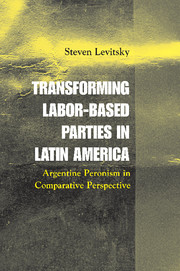Book contents
- Frontmatter
- Contents
- Figure and Tables
- Acknowledgments
- 1 Labor-Based Party Adaptation in the Neoliberal Era: Rethinking the Role of Party Organization
- 2 Origins and Evolution of a Mass Populist Party
- 3 An “Organized Disorganization”: The Peronist Party Structure in the 1990s
- 4 Populism in Crisis: Environmental Change and Party Failure, 1983–1985
- 5 From Labor Politics to Machine Politics: The Transformation of the Peronist Party–Union Linkage
- 6 Menemism and Neoliberalism: Programmatic Adaptation in the 1990s
- 7 A View from Below: Party Activists and the Transformation of Base-Level Peronism
- 8 The Paradox of Menemism: Party Adaptation and Regime Stability in the 1990s
- 9 Crisis, Party Adaptation, and Democracy: Argentina in Comparative Perspective
- References
- Index
7 - A View from Below: Party Activists and the Transformation of Base-Level Peronism
Published online by Cambridge University Press: 22 December 2009
- Frontmatter
- Contents
- Figure and Tables
- Acknowledgments
- 1 Labor-Based Party Adaptation in the Neoliberal Era: Rethinking the Role of Party Organization
- 2 Origins and Evolution of a Mass Populist Party
- 3 An “Organized Disorganization”: The Peronist Party Structure in the 1990s
- 4 Populism in Crisis: Environmental Change and Party Failure, 1983–1985
- 5 From Labor Politics to Machine Politics: The Transformation of the Peronist Party–Union Linkage
- 6 Menemism and Neoliberalism: Programmatic Adaptation in the 1990s
- 7 A View from Below: Party Activists and the Transformation of Base-Level Peronism
- 8 The Paradox of Menemism: Party Adaptation and Regime Stability in the 1990s
- 9 Crisis, Party Adaptation, and Democracy: Argentina in Comparative Perspective
- References
- Index
Summary
This chapter examines the relationship between the PJ and its activist base in the context of the Menem government's neoliberal turn. Activists are often believed to be more ideologically driven than party leaders (May 1973; Koelble 1992, 1996; Ware 1992). If that is the case, then we should expect that Peronist activists, who have historically been almost uniformly antiliberal, would have either actively opposed Menemism or abandoned the party in droves in the 1990s. Yet as Chapter 6 showed, the Menem leadership confronted little intraparty resistance in the 1990s. And although Peronist activists did tend to be critical of the Menem program, relatively few of them left the party. In fact, the PJ's activist base remained quite vibrant, and this base-level activism contributed in an important way to the government's political success.
The chapter attributes the PJ's capacity to maintain its activist base to two factors: (1) increased access to state resources and (2) a decentralized party structure. The combination of state resources and local autonomy allowed activists who were critical of Menem to continue to engage in traditional Peronist practices even as the national party abandoned them. Yet if the PJ's mass linkages persisted through the 1990s, they were transformed in important ways. As state resources became the primary currency of exchange among activists, the personal, ideological, and union-based ties that had long sustained local Peronist organizations began to erode.
- Type
- Chapter
- Information
- Transforming Labor-Based Parties in Latin AmericaArgentine Peronism in Comparative Perspective, pp. 186 - 216Publisher: Cambridge University PressPrint publication year: 2003



